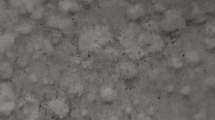Conclusions
A study of the contact reaction of bakor and chamotte refractories showed that at 1250°C a contact zone is formed consisting of glass and needle crystals of mullite. With rise in the temperature of heat treatment, mullitization is increased as a result of the dissolution of grains of chamotte and corundum in the glass, with subsequent crystallization of mullite from it. Starting at 1350°C the glass penetrates deeply from the glassy zone into the chamotte and bakor refractories, reacting with their glass phase. As a result of this the composition of the glass phases of both materials in the contact zone is evened out. At 1600°C we note the presence of a small amount of newly formed zircon.
Similar content being viewed by others
Literature cited
O. N. Popov, V. N. Orlova, L. B. Borovkova, and V. L. Balkevich, Ogneupory, No. 5, 56–57 (1981).
Inventor's Certificate No. 844610, V. N. Orlova, O. N. Popov, and V. L. Balkevich, Byull. Izobret., No. 25, 134 (1981).
Author information
Authors and Affiliations
Additional information
Translated from Ogneupory, No. 9, pp. 10–13, September, 1984.
Rights and permissions
About this article
Cite this article
Balkevich, V.L., Medvedovskaya, É.I., Popov, O.N. et al. Contact reaction between bakor and chamotte refractories. Refractories 25, 502–506 (1984). https://doi.org/10.1007/BF01397829
Issue Date:
DOI: https://doi.org/10.1007/BF01397829




